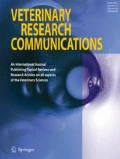Abstract
Pseudorabies (PR, Aujeszky’s disease) is an acute, contagious viral disease that affects a wide range of domestic and wild species. In the present study, an outbreak of PR in sheep induced by attenuated live vaccine (Bartha-K16) was diagnosed and analyzed in China. The presence of PR virus (PRV) in brain samples from infected sheep was confirmed by gC gene polymerase chain reaction amplification and PRV-like particle observation by electron microscopy. The molecular characterization of the PRV was performed with homology analysis and phylogenetic tree construction based on the gC gene. This is the first description of an outbreak of PR induced by a live attenuated vaccine (Bartha-K16), indicating that this vaccine is unsuitable for use in sheep.

References
Aleman N, Quiroga MI, Lopez-Pena M, Vazquez S, Guerrero FH, Nieto JA (2003) L-particle production during primary replication of pseudorabies virus in the nasal mucosa of swine. J Virol 77(10):5657–5667
Clark L, Molitor T, Gunther R, Joo H (1984) Pathogenicity of a modified-live pseudorabies vaccine virus in lambs. J Am Vet Med Assoc 185(12):1535
Davison AJ, Eberle R, Ehlers B, Hayward GS, McGeoch DJ, Minson AC, Pellett PE, Roizman B, Studdert MJ, Thiry E (2009) The order Herpesvirales. Arch Virol 154(1):171–177. doi:10.1007/s00705-008-0278-4
Ebel ED, Hornbaker RH, Nelson CH (1992) Welfare effects of the national pseudorabies eradication program. Am J Agric Econ 74(3):638–645
Fonseca AA, Camargos MF, de Oliveira AM, Ciacci-Zanella JR, Patricio MAC, Braga AC, Cunha ES, D’Ambros R, Heinemann MB, Leite RC, dos Reis JKP (2010) Molecular epidemiology of Brazilian pseudorabies viral isolates. Vet Microbiol 141(3–4):238–245
Hampl H, Ben-Porat T, Ehrlicher L, Habermehl KO, Kaplan AS (1984) Characterization of the envelope proteins of pseudorabies virus. J Virol 52(2):583–590
Huanchun C, Liurong F, Qigai H, Meilin J, Xufeng S, Meizhou W (1998) Study on the isolation and identification of the Ea strain of pseudorabies virus. Chin J Anim Vet Sci 2
Ishikawa K, Tsutsui M, Taguchi K, Saitoh A, Muramatsu M (1996) Sequence variation of the gC gene among pseudorabies virus strains. Vet Microbiol 49(3–4):267–272
Karger A, Mettenleiter TC (1996) Identification of cell surface molecules that interact with pseudorabies virus. J Virol 70(4):2138–2145
Kluge J, Beran G, Hill H, Platt K (1999) Pseudorabies (Aujeszky’s disease). Dis Swine 7:312–323
Kojnok J (1962) The role of pigs in the spreading of Aujeszky’s disease among cattle and sheep. Acta Vet Sci Hung 12:53–57
Mettenleiter TC, Zsak L, Zuckermann F, Sugg N, Kern H, Ben-Porat T (1990) Interaction of glycoprotein gIII with a cellular heparinlike substance mediates adsorption of pseudorabies virus. J Virol 64(1):278–286
Muller T, Hahn EC, Tottewitz F, Kramer M, Klupp BG, Mettenleiter TC, Freuling C (2011) Pseudorabies virus in wild swine: a global perspective. Arch Virol 156(10):1691–1705. doi:10.1007/s00705-011-1080-2
Pirisinu L, Migliore S, Di Bari MA, Esposito E, Baron T, D’Agostino C, De Grossi L, Vaccari G, Agrimi U, Nonno R (2011) Molecular discrimination of sheep bovine spongiform encephalopathy from scrapie. Emerg Infect Dis 17(4):695
Pomeranz LE, Reynolds AE, Hengartner CJ (2005a) Molecular biology of pseudorabies virus: impact on neurovirology and veterinary medicine. Microbiol Mol Biol R 69(3):462–500
Pomeranz LE, Reynolds AE, Hengartner CJ (2005b) Molecular biology of pseudorabies virus: impact on neurovirology and veterinary medicine. Microbiol Mol Biol Rev: MMBR 69(3):462–500. doi:10.1128/MMBR.69.3.462-500.2005
Ren Y, Li G, Su D, Yang Q, Ren X (2012) Characterization of pseudorabies viruses produced in mammalian cells by viral genome transfection. Afr J Biotechnol 11(17):4098–4102
Rue CA, Ryan P (2008) Pseudorabies virus glycoprotein C attachment-proficient revertants isolated through a simple, targeted mutagenesis scheme. J Virol Methods 151(1):101–106. doi:10.1016/j.jviromet.2008.03.015
Thawley D, Gustafson D, Beran G (1982) Swine pseudorabies eradication guidelines. Minnesota Livestock Conservation Institute, South St Paul, pp 1–11
Thawley D, Wright J, Solorzano R (1980) Epidemiologic monitoring following an episode of pseudorabies involving swine, sheep, and cattle. J Am Vet Med Assoc 176(10):1001–1003
Van Alstine W, Anderson T, Reed D, Wheeler J (1984) Vaccine-induced pseudorabies in lambs. J Am Vet Med Assoc 185(4):409
Wathen MW, Wathen LM (1986) Characterization and mapping of a nonessential pseudorabies virus glycoprotein. J Virol 58(1):173–178
Zhu Y, Zhang G, Shao M, Lei Y, Jiang Y, Tu C (2011) An outbreak of sheep rabies in Shanxi province, China. Epidemiol Infect 139(10):1453–1456
Acknowledgments
This work was financially supported by State Key Laboratory of Veterinary Etiological Biology Lanzhou Veterinary Research Institute (SKLVEB2012KFKT009), National Natural Science Foundation of China (Grant No.31201914), China Agriculture Research System (CARS-39) and China Postdoctoral Science Foundation funded project (013M53068).
Author information
Authors and Affiliations
Corresponding author
Additional information
Hanjin Kong and Keshan Zhang contributed equally to this work.
Rights and permissions
About this article
Cite this article
Kong, H., Zhang, K., Liu, Y. et al. Attenuated live vaccine (Bartha-K16) caused pseudorabies (Aujeszky’s disease) in sheep. Vet Res Commun 37, 329–332 (2013). https://doi.org/10.1007/s11259-013-9568-8
Accepted:
Published:
Issue Date:
DOI: https://doi.org/10.1007/s11259-013-9568-8

